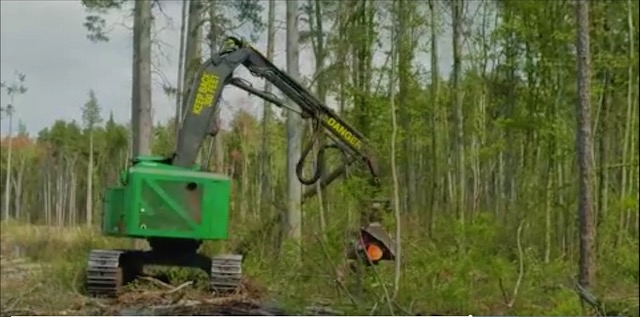Slick Propaganda In The Pinelands – PBS Pushing “Young Forest” Falsehoods Used To Justify Logging
PBS Explicitly Supports “Clearcuts” As A Necessary “Young Forest” Management Tool
Forest Ecology and Climate Science Ignored And Distorted
NJ Audubon And DEP Scams Are Praised
(PBS documentary screen shot of clearcut logging in the Pinelands to create a “Young Forest”. Maybe that logging was done by DEP and the machine funded by the Pentagon “REPI” grant – see below)
We’ve been writing for some time about the national propaganda campaign by the forest products industry to promote a “Young Forest Initiative” (YFI). That PR campaign is designed to dupe the public – who strongly support preservation of forests – into accepting logging under various scientifically false or dubious rationales.
So, I was appalled – but not surprised – to watch a PBS “documentary” “Keeping the Pinelands” on NJ Pinelands forests. That 26 minute video spouted every false and misleading propaganda narrative and talking point of the forest products industry funded “Young Forest Initiative”.
The full extent of this industry propaganda was revealed by this scientific paper, which exposed the misleading claims of the proponents of the YFI. Read this paper before watching the PBS video, see:
1.2.1. Genesis of the campaign and the “Young Forest Initiative”
A concerted campaign is working to slow and reverse the natural decline in early-successional habitat and species that accompanied the regional reduction in deforestation, intensive forestry, and agriculture. This campaign is promoting early-successional habitat through multiple activities: clearcutting, “group selection,” and other forms of patch clearfelling in established forests; intensive “mechanical treatments” such as brushhogging and mowing; and herbicide application and prescribed fire in successional habitats and younger forests, which are often accompanied by other mechanical treatments (DeGraaf and Yamasaki, 2003; Oehler et al., 2006; American Bird Conservancy, 2007; Schlossberg and King, 2007; King et al., 2011; Yamasaki et al., 2014).
[…]
Wildlife Management Institute (WMI) soon began expanding the YFI to a national campaign (Gassett, 2018; Weber and Cooper, 2019). Recognizing the controversial nature of such widespread forest-clearing, the organization hired a marketing firm to “shape an overall communications strategy” (Seng and Case, 2019). This firm administered opinion surveys and focus groups that showed most forest landowners value beauty, scenery, nature, and biodiversity far more than logging or financial return. A plan was then devised to promote early-successional habitats through an extensive network of partnerships. Terms which focus group participants found unappealing, such as clearcutting, early-successional habitats, shrub, and scrub, were replaced with the more appealing “young forests.” Simple and positive language emphasized forest “health,” wildlife, habitat diversity, and scientific-sounding outcomes. A pseudo-historical pitch was crafted to emphasize the decline of once common and familiar species without acknowledging the highly artificial and historically anomalous nature of their former abundance (see Table 2 for more details). Numerous publications were produced, such as, “Talking About Young Forests,” to help “natural resource professionals…effectively advocate for creating and managing young forest habitat on public and private lands” (Oehler et al., 2013).
It’s almost as if the industry spinners wrote the script – or PBS worked off their talking points.
The PBS narrative was delivered by all the usual suspects involved in the NJ “forest management” campaign to promote logging and spur revitalization of the forest products industry in NJ, all while keeping DEP bureaucrats and their sycophants in the conservation community well fed, see:
My sense is that this PBS documentary was pitched and framed by NJ Audubon and originated as a response to very embarrassing recent debacles, including:
1) DEP’s clearcut of over 20 acres of forested wetlands in Glassboro Wildlife Management Area
This was a hugely embarrassing story that received widespread national scathingly critical coverage, including by The NY Times, Associated Press and Philadelphia Inquirer .
That debacle clearly exposed the scientific fraud behind the YFI claims of logging to support wildlife habitat; see:
2) the DEP’s massive 1,400 acre logging project in the heart of the Pinelands.
That logging was allegedly to provide “carbon defense” and reduce wildfire risk, but it was actually a Pentagon funded project to protect the training mission of the US Air Force Warren Grove base, see:
3) National exposure and scathing criticism of NJ Audubon and YFI, see:
4) Criticism of DEP’s forestry management programs, see:
5) Failure to address climate emergency and incorporate climate science in DEP forest management:
I urge you to watch the full PBS “documentary” – but first read the science exposing the “Young Forest Initiative” public relations campaign (link here and link and excerpt above).
Then see how many specific examples you can find.
The good folks at NJ Forest Watch summed things up pretty well with this note:
It is riddled with greenwashing through and through. It’s horrible how looking at the credits it’s all the promoters of YFI in NJ! You would think PBS would present both sides …what happened? This is undoubtedly unfortunate and what about the push for local forestry and building with wood as “carbon neutral “… have these folks not read the latest climate science?
The clip about showing the reintroduction of Bobwhite quail …is crazy as what they don’t tell the public it’s so the hunters have something to kill in the next few hunting seasons. (All of those Quail were released so hunters could kill them -It’s disgusting).The comments about “public opinion” and how most trees are 80-100 years , and last “ecological forest management “ is just further SPIN.
Calling all forest ecologists and friends of forests: I challenge you to provide additional and more specific examples!
Send me a list and we can create a comprehensive debunking that will set the record straight.
